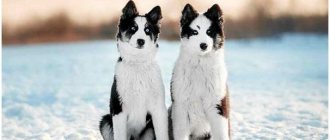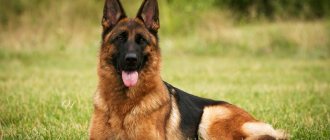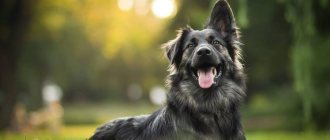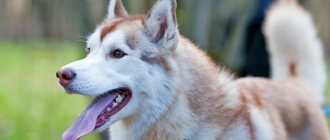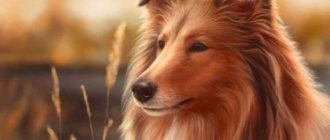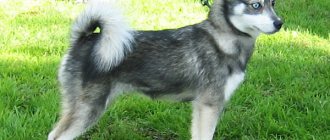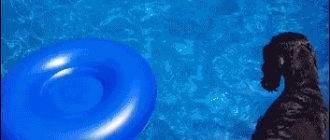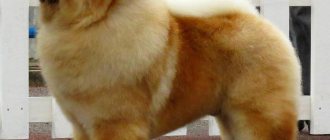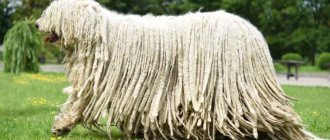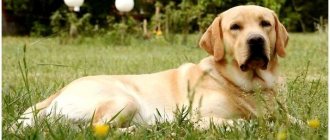Northern dog breeds are those pets that can easily withstand any climatic conditions and especially frost, they are hardy, have thick hair and a good sense of smell. Interestingly, many discoveries in the Arctic were made with the help of northern dogs and sled breeds. Because they were bred specifically for harness work.
It is important to understand that many of the northern dog breeds can be used as pets, but not in the south. After all, due to the thick fur and undercoat, it will be difficult for pets to withstand the heat. Especially if you want to use them as guards and hunters.
The most popular breeds are:
- Siberian Husky;
- Alaskan Malamute;
- Samoyed
Siberian Husky
The Siberian Husky is similar in appearance to the Malamute, but smaller. The breed was bred by breeders; previously they were used by the tribes of the north as hunting and sledding dogs, but with heavy loads. The name comes from the word “eski”, as the tribes of the Arctic were called. The peculiarity of the breed is that they are able to transport heavy loads over long distances. They also have blue eyes, thick fur and weigh up to 30 kg. At the moment the pet is used as a companion and circus dog for shows.
Saint Bernard
The St. Bernard gained its fame in 1992 after the appearance of a film in which the main character was the super slobbery and always causing problems Beethoven. Of course, not all St. Bernards are capable of causing a stir, but representatives of the breed have the same impressive size - their weight is 54-91 kg.
Fluffy giants do not have energy and are not prone to active games, but they are truly loyal, strong and ready to travel kilometers in search of missing people.
Alaskan Husky
The Alaskan Husky is still not included in the FCI classification, but it is considered the ancestor of the Siberian Husky. The breed itself appeared naturally and has much in common with the new northern husky, although it is slightly smaller in size, up to 25 kg. The tribes used the Alaskan husky for hunting and home guarding, and harnessed it to a sled. The coat is thick, gray, white, brown in color.
How to train dogs to walk and run in sleds
Pedigree dogs begin training at the age of 8-9 months. The minimum training requirement is eight weeks. The first four are spent on training - the dog must learn commands, get used to running at the same speed as the rest of the pack, and unquestioningly obey the owner - in the harsh northern lands there is no way without this.
Curious ! The word "husky" comes from a distorted abbreviation of "eski", that is, "Eskimo".
The second month of training is devoted to physical training - the dog must become powerful enough to withstand significant loads, run for a long time and pull a heavy team.
Alaskan Malamute
The Alaskan Malamute was bred in the north by wild tribes more than three thousand years ago, among its ancestors is the polar wolf. The name comes from the name of the Malemute tribe. They were used for riding in a sled, transporting cargo and protecting homes. The coat is thick with undercoat, color is wolf. The pet requires attention and constant physical training.
Origin story
Huskies were bred not only for company while hunting, but mainly as a sled breed . One team needed up to 10 dogs, but since they are unpretentious in food, it was not difficult to keep such a number of animals.
In the 17th and 18th centuries, the Russian Empire began to actively explore the North, which gave a good impetus to the development of sled dog breeding. About 20 animals began to be used for one team, as the sledges increased in size.
The Alaska Gold Rush increased the demand for sled dogs in America. Since the beginning of the 20th century, Americans have imported many Husky dogs from the Far East. Huskies are excellent in rescue operations, and sled dog racing is a fun sport .
Reference . Translated from English, the word husky means “husky.” The dogs were so named for the characteristic sounds they make when growling. Another version says that the name of the breed comes from the word "Eski", a shortened version of the address to the Eskimos.
Homeland of dogs
The origin of the Husky is extremely confusing, but most people believe that the birthplace of the breed is Northeast Asia.
How did you get out?
The friendship between man and husky has lasted for about three thousand years. In fact, this breed was obtained by crossing a northern dog and a wolf . The result was a hardy, loyal and beautiful animal.
In the conditions of the Far North, dogs of this breed turned out to be good helpers for the local population in hunting, protecting houses and reindeer herding.
Northern nomads, in other words, the Chukchi, are the founders of the husky breed.
Where do they live now?
Many sled dogs live in their historical homeland , performing their centuries-old duties - sledding.
But the docile nature, unpretentiousness and beauty of these wonderful animals have long conquered the whole world.
Therefore, Husky dogs can be found in almost any locality.
Samoyed dog
Samoyeds are one of the most popular dogs in the world; their appearance resembles a cute bear. The name comes from the Samoyed tribe. Previously used for herding animals, they rarely took part in riding. Only after the start of expeditions to the Arctic, the Samoyed dog began to be used in sled riding. The breed is distinguished by its endurance, activity, and unpretentiousness in the matter of nutrition. The coat is fluffy white, average size – up to 30 kg.
Samoyed
www.petpaw.com.au
The Samoyed has been around for more than 3,000 years and, according to legend, descended from a domesticated white wolf. This is a large dog with long, snow-white hair.
The Samoyed is one of the rare and most expensive breeds. He is an unpretentious worker who understands people very well. He has a hard time with loneliness, has a very strong need for a “pack”, can be a little stubborn and never shows aggression. In America, Samoyeds are called good mood dogs and are recommended for people suffering from depression.
All northern dog breeds are united by a pronounced character, a little stubbornness, the need for a reliable, confident owner and regular outdoor games. These animals are not for beginners who dream of unobtrusively “decorating the sofa.” But they pay for care and love with devotion and faithful service.
Header photo from website: skadi.se
Strong, hardy, undemanding when it comes to food and can withstand severe frosts without problems - this is how we can generally characterize the breeds of northern dogs. In the past, many discoveries during the exploration of the Arctic were made precisely thanks to northern sled dogs (most breeds bred in the northern regions of the planet were used specifically for sled work). Even today, in the age of cars and airplanes, it is often necessary (due to difficult weather conditions) to use sled dogs.
Karelian Bear Dog
Externally, the Karelian Bear Dog has much in common with the Russian Laika, although this breed is much more common. Used for hunting, tracking large animals and home protection. An excellent sense of smell and hunting qualities are genetically determined, but a bear dog needs to be raised and trained constantly. The coat is thick, fluffy, and red in color.
Pyrenees Mountain Dog (Great Pyrenees)
Used to herd livestock on the steep mountain slopes of France, Pyrenean mountain dogs are capable of negotiating dangerous terrain and difficult terrain.
These large animals, weighing 36-45 kg, are elegant and calm, which is why they were chosen as the royal dog of the French Republic. “Great Pyrenees are the most gentle of the guard breeds, the longest living of the giant dogs, and yet they do not require special care,” says Carrie Stewart Rarks, president of the American Pyrenees Mountain Dog Breeders Club. – These animals love winter; their thick, double-layered coat provides protection from extreme cold (except in the lowest arctic temperatures).”
Yakut Laika
The Yakut Laika appeared in the north-east of Russia in the area of “dog rivers”. Pets were used for sledding and hunting large animals. Externally, the Yakut Laika has a medium size, strong paws, thick coat of spotted color (white-black, black-red). The pet easily tolerates any climatic conditions and is quite hardy.
https://youtu.be/ugnGhpr9wLw
Standards
General impression
A fast and light dog of medium size. It has a beautifully built, dense body, with a well-defined coat, a fluffy tail, curved in a ring when active and freely falling when at rest, and erect ears. Without excess weight, the muscles are well developed and dense. Females have a more feminine build, while males have a more masculine build. A loose physique is excluded.
Measurements
Measurements (height): male from 52.5 to 59 cm, female from 50 to 55 cm.
Body weight : female from 16 to 22.7 kg, male from 20.4 to 29 kg. It must correspond to the height of the animal.
The distance from the shoulder to the root of the tail should be greater than the height.
Standards: heads
Almond-shaped eyes , slightly slanted, with a non-malicious expression. Eye color from blue to brown, different eye colors are allowed.
Ears. High sitting, triangular in shape, medium size. With good feathering, not thin, have a slightly rounded tip, erect.
Skull box. Should be in relation to the body, slightly rounded at the top, medium in size, widening at the widest part (near the eyes).
The muzzle is of medium size, narrower in the nose area, the latter should not be rounded or pointed.
Nose. Most often it is pure black, but brown is also allowed for red-colored dogs and white-pink for white-colored dogs. There is also “snowy”, this is when pink stripes may appear on the black lobe in winter.
Dense lips with good pigmentation . Scissor bite.
Torso
Neck. Proudly raised, curved, standard length. With measured movements, it stretches forward a little.
Breast. Medium in width, but deep and powerful. The bottom of the chest is located at or slightly higher than the elbow. The ribs stand back noticeably from the spine, flattening towards the sides, thereby providing freedom for the movement of the limbs.
Back. Medium size, strong, completely straight from the end of the withers to the croup.
The lumbar region is narrower than the ribs, with a fold, slightly sloping. The croup is slightly sloping.
Limbs
The paws are of medium size with good furring between the toes, oval, with fleshy, dense structure, pads and dewclaws, which are best removed to avoid their further injury.
Front. The shoulder part is pressed tightly, always directed not towards the ground, but back.
The limbs are well developed, strong and resilient. When viewed from the front, they are parallel, straight, slightly spaced from one another. The elbow joints are also pressed tightly to the body, turning both inward and outward is excluded. The distance from the elbow to the withers is slightly shorter than to the floor. Strong, but not large bones, strong and mobile joints.
Rear. Placed widely among themselves, but parallel to one another (when viewed from the side). Strong, muscular thigh, with well-defined stifle angles, low and well-defined hock joint.
Coat. The coat is medium in length and double in structure, but does not hide the outlines of the animal’s body. Contains a soft, good density undercoat, which creates the basis for the support of the top coat. The outer part of the hair is smooth and well pressed to the body, sticking out or coarse hair is excluded.
Trimming around the paws, on the sides and between the toes is allowed, but no more.
Color. Any color is acceptable, from completely white to black. There may be all kinds of markings on the head, as well as patterns in the form of stripes, which characteristically distinguishes huskies among all breeds.
Greenland sled dog
The Greenland sled dog is a rather rare breed in our time; it originated in Greenland and was used for sled riding and hunting. Outwardly, it is a strong, hardy, muscular dog. The coat is thick, the color is white, spotted, gray, brown. The peculiarity is that the Greenland sled dog adapts to all living conditions, but it is better not to keep it in an apartment.
Read: Dog breeds for apartments.
Riding sport and its varieties
The Samoyed is a wonderful nanny.
Man has long come up with more reliable and convenient ways to cross snowy expanses than using a dog harness. But art still did not die - it turned into a sport.
Today, there are several varieties - some are held in the open air, in winter, and others - on special sites that have a hard surface, but without snow.
Snowmen usually test the endurance of dogs - they have to run tens of kilometers over difficult terrain. The Norwegian sled mix has shown itself to be excellent on snowless trails - the dogs have to drag a kart or scooter, and in some cases even a special bicycle, rather than the usual harness.
East Siberian Laika
The East Siberian Laika includes several subspecies of dogs that are still developing and transforming in appearance. Pets appeared on the territory of Russia and were bred by ancient settlements in the eastern part of the country. Externally, these are large dogs weighing up to 50 kg, the coat is thick with undercoat. Laikas were used as sled dogs and hunting dogs. The East Siberian Laika has a heavy temperament, but easily tolerates frost and cold.
How to choose?
When choosing a northern dog, it is important to pay attention to 3 main factors:
- purpose (as we found out, there are sled, hunting and guard dogs) - depending on the category to which the animal belongs, it will have certain behavioral characteristics and characteristic temperament traits;
- appearance - a pet should attract and delight you with its appearance, it is also important to pay attention to the dimensions and dimensions, evaluate the size of your living space and whether this or that dog will fit on them;
- care rules - some animals require specific care measures, while others are absolutely unpretentious in this regard.
For a story about sled dogs, watch the following video.
Nordic dog breeds include Scandinavian, Russian, Canadian and others, which can withstand cold and work in difficult climatic conditions. These are strong and resilient watchmen, guards and companions. The cynological organization UnitedKennelClub has more than 3 dozen such breeds, among which it is not so easy to select the most interesting.
West Siberian Laika
The West Siberian Laika also appeared in the north, in Siberia, but in the western part. These pets are excellent hunters of large animals; they have never been used for transporting goods. Now they can be used as guards for homes. Height – up to 55 cm, weight 30 kg, wool – thick, light, black or brown.
Russian-European Laika
The Russian-European Laika was bred artificially in Russia and is used for hunting and driving large animals, but after special training. Externally, it is a large, powerful dog, up to 60 cm tall. The coat is medium thick, with undercoat, the color is black, white, spotted, brown. Nowadays the Russian-European Laika is used as a guard dog or a companion.
Interestingly, many breeds of huskies were bred artificially after selecting the best native breeds from the vast expanses of Siberia. Therefore, each species has a different size, color and purpose.
Features of education and training
Huskies are working dogs with a well-developed sense of teamwork.
If the leader had to independently determine the direction of movement, then the rest had other tasks - to run without slowing down and without losing the rhythm. Anyone who got out of the harness was punished by the pack. This determines the nature of the dogs’ behavior - they work with full dedication, evaluate the activities of others and independently look for ways out. Strictness and consistency are needed in raising a pet, otherwise a “spoiled” dog will be uncontrollable. He can pretend that he does not hear or does not understand the command if he gives any slack at least once. Huskies are capable of obeying, but this requires a strong river, otherwise he will gladly take on the role of leader of the pack, and here it is not the owner, but the dog himself who will make decisions.
There is little that can frighten dogs of this breed, so physical pressure will not give the expected result - the dog will not obey unquestioningly. Huskies are capable of adopting the habits of other dogs, so a positive example can be a good help in training. But there is no point in trying to turn a sled dog into a service dog; he will only learn to copy behavior, but without innate qualities it will be useless.
Punishment in training should be present, but not by causing pain, but by subduing the pet. This could be the use of a stern voice, inflexibility. You can also act like the leader of the pack - press the head of the disobedient pet to the ground and hold it until the dog stops resisting. This is usually enough for the dog to appreciate the advantages of the owner and accept him as a leader.
To consolidate the results, you can complicate your training by adding long runs to the point of exhaustion and training at altitude - with ups and downs. Dogs appreciate rewards - treats, praise, affection, but they should receive them only according to what they deserve.
Norwegian Lundehund
The Norwegian Lundehund is now on the verge of extinction; the breed was used for hunting on rocks or in water, now as a companion. The Lundehund is popular in Norway and all northern countries and requires the owner's attention and training. Externally - medium size, massive paws, large erect ears. The coat is thick, there is an undercoat, color is gray, white, red, weight up to 8 kg.
Thoroughbred hunters
Their main purpose is to hunt small and large animals.
Laika Russian-European
The breed is distinguished by impeccable hearing and visual acuity. The animal is infinitely devoted to its owner and does not show aggression towards strangers. The dog needs training and is happy to follow commands, but only if he is in the mood for it.
They are distinguished by excellent health. An adult dog has a body weight from 19 to 24 kg, height from 49 to 60 kg.
Laika East Siberian
This is the largest species of husky. The dog has an excellent sense of direction and is hardy to any climatic conditions. He has an easy-going character and no aggression towards strangers.
Sharing with other pets that the dog may consider as prey is not recommended. There are no particular difficulties in grooming procedures, and she is completely unpretentious when it comes to food. The dog requires intense daily exercise. Dimensions of an adult dog: body weight from 17 to 24 kg, height from 53 to 63 cm.
Laika West Siberian
The breed was bred for extreme northern climates. The dogs are resilient and can withstand intense physical activity. The pet will feel good in a family with children.
The character is friendly, while the dog protects and protects its home and owner. When caring for huskies, they require maximum attention; they are active, energetic, and require many hours of walks. Dimensions of an adult dog: height from 51 to 65 cm, weight from 19 to 26 kg.
Emthund
These are truly unsurpassed hunters. First, the dog tracks its prey and drives it into a corner, and only then signals its find to its owner with a joyful bark. The breed is incredibly powerful and resilient, but behind this strength lies a friendly nature.
The pet loves children very much and is ready to play with them all day long. The animal needs physical activity and training with frequent training. Dimensions of an adult dog: height from 56 to 66 cm, weight up to 32 kg.
Norrbotten Spitz
Unlike the massive northern breeds, this dog is small and compact in size. The coat color is light. The dog is an ideal hunter, hardy, despite its small size, very strong.
Character – soft, friendly, not at all prone to aggression. The breed is used as a hunting and guard dog. Male dimensions: weight from 10 to 16 kg, height from 41 to 48 kg. The female’s height is from 41 to 45 cm, and her weight is from 7 to 13 kg.
Laika Karelian-Finnish
The real decoration of the breed is its amazing color - noble, golden. The animal is playful, cheerful, and quickly adapts to the family. Laika is a good guard, protects its owner from strangers, has no tendency to aggression, but if it feels threatened, it can bare its teeth.
Character – strong, leadership. When training, a person should immediately show that he is the owner, otherwise it will be difficult to curb the dog’s temper. The dog can be kept both in an apartment and in a private house. It is not recommended to keep your husky together with other pets; this can awaken the hunting instinct in it. Dimensions of an adult animal: height from 41 to 51 cm, weight from 10 to 16 kg.
Bear Karelian dog
The dog is focused on hunting; there must be a strong, strict owner next to him. The breed is distinguished by its courage, endurance and devotion. The dog does not show aggression towards strangers, which cannot be said about its attitude towards other animals.
This dog needs constant training and regular physical activity, its health will depend on this. Adult pets weigh from 19 to 24 kg, height – from 48 to 62 cm.
Lundehund Norwegian
The breed is agile, flexible, and has been used by people for hunting for a long time. A distinctive feature of the representatives is that with the help of six toes on each paw, the dog easily moves along steep cliffs, leaving no chance for its prey. This is an extremely rare breed, which at a certain period of time almost disappeared completely, but breeders were able to restore it and replenish its numbers.
The animal's psyche is stable, compact in size, weight from 5 to 8 kg, height 29-39 cm. In addition, these are strong and hardy pets that should be regularly exercised physically. Only with regular training will the dog behave calmly at home.
Lundehunds are susceptible to diseases of the digestive system; owners need to carefully select their food.
Norwegian Elkhound
The breed is unique and rare. Dogs are able to survive in extremely harsh climates. At home he will be a good, loyal and affectionate pet. Sharing with other pets is not recommended, but there is an exception - if both animals grew up together, they will get along well with each other.
They love space and freedom, so it is better to keep the dog in a private house with a large yard. Dimensions: from 21 to 27 kg, height from 40 to 53 cm.
Emthund (Swedish Husky)
The Jemthund or Swedish Husky was bred in Sweden to hunt large animals because the breed is characterized by endurance, a good sense of smell, aggression and persistence. The Emthund will not take root in apartments or city conditions and requires constant training. With proper upbringing, it can act as a guard or companion. Externally, it is a medium-sized dog, gray or wolf in color with muscular paws.
Bernese Mountain Dog
This breed combines strength, speed, agility and devotion to its owner. At the same time, animals have a mild temperament and do not require a lot of exercise.
Bred in Switzerland as draft dogs and as sled dogs, Bernese Mountain Dogs are large and strong animals, and therefore are capable of carrying heavy equipment (both their own and part of their owner's).
Norwegian Buhund
The Norwegian Buhund originated in Iceland and is related to the Icelandic Sheepdog. Previously used for grazing and corralling animals, now - as a companion. You can keep it in an apartment if you walk it a lot and train it; the qualities of a guard and a hunter are instilled in it from birth. Externally, it is a large breed with muscular paws and thick, light-colored hair.
Health problems
Those wishing to buy a husky need to know that in addition to common infectious diseases, the following problems may occur:
- Baldness on the scalp, accompanied by itching, is associated with a deficiency of zinc in the body. The problem can be solved quite easily by contacting a veterinarian and giving food preparations containing microelements.
- Eczematous phenomena on the skin associated with the dog's thick coat. More often it manifests itself in the form of weeping eczema, especially in the hot season. To prevent this, it is necessary to comb the dog thoroughly, and if the disease has already manifested itself, the help of a veterinary specialist .
- Thyroid gland dysfunction is manifested by various symptoms: increased fatigue, deterioration of coat quality, lethargy, drowsiness, infertility, poor general condition and others. For diagnosis, a biochemical blood test .
- Quite often among male dogs there are cryptorchids (one of the testes does not descend into the scrotum and remains in the abdominal cavity). This problem is fraught with the formation of tumor-like inguinal hernia formations in the undescended testis. Diagnosed by examination and palpation by a veterinarian. If detected, castration is recommended.
- Due to increased emotionality, huskies have a hereditary predisposition to the development of such a serious disease as epilepsy. You need to pay attention to this when choosing a puppy (the health status of the parents and grandparents).
Lapinporokoira
Lapinporokoira or Lapp Reindeer Dog appeared artificially after the selection of aboriginal hunting dogs of the north. After the ancient tribes began to breed large animals, the reindeer herding dog began to be used for herding and sledding. For some time the breed was on the verge of extinction. Externally, it is of medium size, muscular paws, and thick black fur.
Suomenlapinkoyira (Finnish Lapphund)
Suomenlapinkoyra or Finnish Lapphund appeared in Finland for hunting, herding and corralling animals, and protecting houses from wild animals. Outwardly it resembles a bear up to 20 kg in size, has thick and fluffy fur of gray, white, spotted color. The Lapphund appeared naturally and is considered a descendant of wolves. Can be kept in an apartment, but requires training.
Main features
Dogs of this breed have soft fur and a calm character , but the most famous feature is their very beautiful, ice-blue eye color.
Husky eyes can come in different shades, but blue is the most common.
Huskies are short animals with thick hair. The tail is curved into a ring. The color can be varied :
- Grey.
- White and grey.
- Brown.
- White and black.
- White.
Swedish Lapphund (Lapland Spitz)
The Swedish Lapphund or Lapland Spitz was bred in the vastness of Lapland for grazing and corralling livestock, and is now used as a companion or decorative dog. Externally, it has a small size, massive paws, thick and shiny fur, and black color. Can be used as a guard, but with proper training.
It is interesting that most northern dog breeds have a kind, easy-going character, despite the fact that they are used for protection and protection. Such qualities as aggression, anger and complete independence are not inherent in them.
Films about northern dogs
Breeds such as the Siberian Husky and the Alaskan Malamute have played leading roles in many films. Moreover, there are films where they even got the main roles, for example:
- “White Captivity” is a film about dogs abandoned at the North Pole; it is the film most often searched for on the Internet. Members of the expedition in Antarctica were urgently evacuated, but 8 dogs of northern breeds remained. For half a year they had to survive on their own in the conditions of the Antarctic winter; not everyone succeeded...
- Snow Dogs is a fun film about northern dogs. One guy gets an inheritance in Alaska; when he went there, he found out that in addition to the house and ordinary things, he also inherited 8 champion sled dogs (Siberian Husky and Alaskan Malamute breeds). What happened next - see in the film.
- The Call of the Wild tells the story of a man and his dog trying to survive in the harsh conditions of Alaska. A dog named Buck constantly hears the howling of wolves from the forest, will he join them or stay with his owner?
- “Balto” is a cartoon about the brave sled dog Balto, who, no matter what, will try to deliver medicine to a remote town in Alaska during a storm.
Other breeds of northern dogs
Greenland dog, photo by Algkalv.
Photo of northern dogs - Yakut Laika.
So we looked at northern dog breeds with photographs and names. Of course, these are not all the breeds bred in the northern regions of the planet, so in the future we will definitely add to this list. And if you can add to it now, don’t hesitate to write in the comments below what other northern dog breeds you know.
